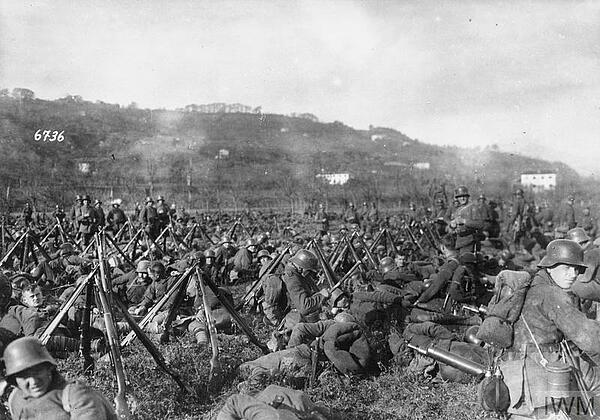The Battle of Caporetto
The Battle of Caporetto was one of the more decisive battles of World War One, resulting in the Italian Army suffering major losses of both men and equipment.
Ahead of the battle, the Italian Army had enjoyed a number of victories around the Isonzo area in north Italy but they had been very costly in terms of casualties. The main enemy in and around the area were Austo-Hungarian forces who were supported by Germany to prevent the loss of the southern front.
Following a number of aerial observations, the Italian Army established that preparations were taking place among the Allies. In response, the Germans decided to attack on a front near Caporetto, which was the weakest point on the Italian front line. The Italians did have the advantage in terms of numbers - with 41 divisions to 35 - but they were thinly spread across this area.

The attack began on 24th October 1917, much to the surprise of the Italians. German commander of the German force, Otto von Bulow, was surprised by the success of the initial attacks. Meanwhile, Italian commander Cadorna ordered the commander at Caporetto to man a defensive line. Unfortunately, commander Capello decided to do the opposite, adopting a policy of aggression that ultimately proved very costly.
By the end of the day, the Germans near Caporetto had advanced 25km. Unfortunately for the Germans, other German attacks elsewhere were less successful. However, the success in the main area surrounding Caporetto means the Italian Army was left confused and lacking in communication. Of course, this meant that the only way of saving the area was to pull forces from other areas, which would have allowed the weaker German advances to progress further.
Despite having been aggressive to begin with, Capello requested for his forces to be withdrawn, but this was rejected by Cadorna who hoped the soldiers would regroup and counter the attack.
This was not to be, and by 30th October the Italian Army had been pushed across the River Tagliamento, which took them a total of four days to cross.
Sadly for the Germans, their advances had been so significant that they hadn’t been able to move their supply lines fast enough. This meant that they were unable to launch a further attack while the Italians retreated and the Italian Army was able to withdraw to the River Piave near Venice.
The battle had a huge impact on the Italian Army, leading to the loss of 300,000 men - 270,000 of these being captured as prisoners. Nearly all artillery guns were also lost and the British and French were forced to send 11 divisions to aid them.
MLA Citation/Reference
"The Battle of Caporetto". HistoryLearning.com. 2025. Web.
